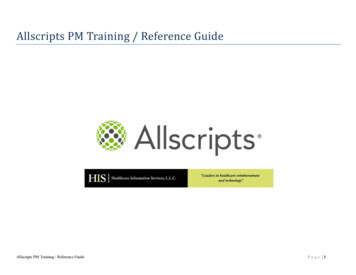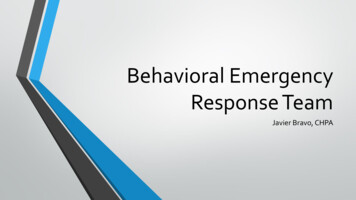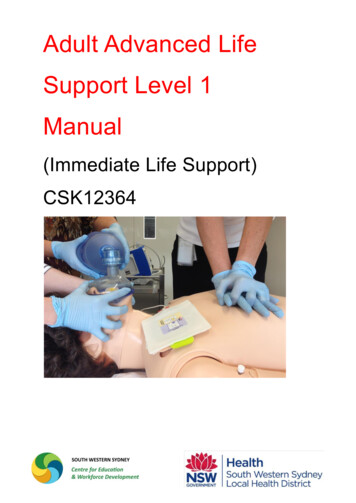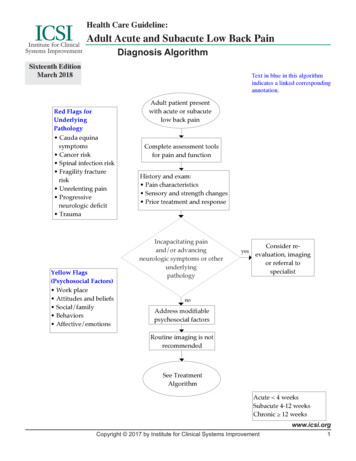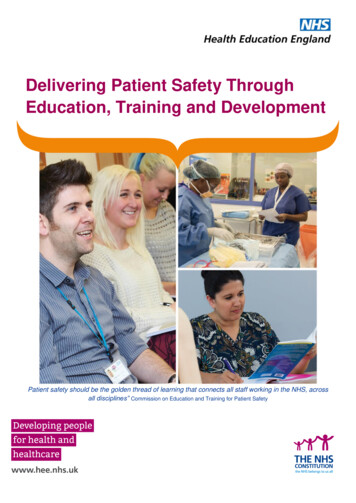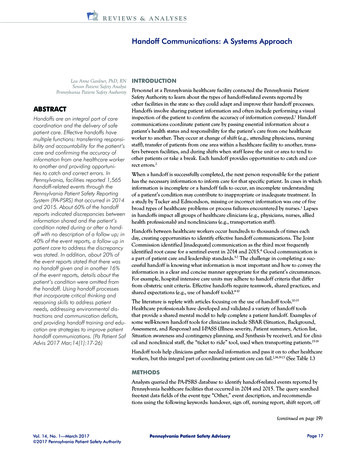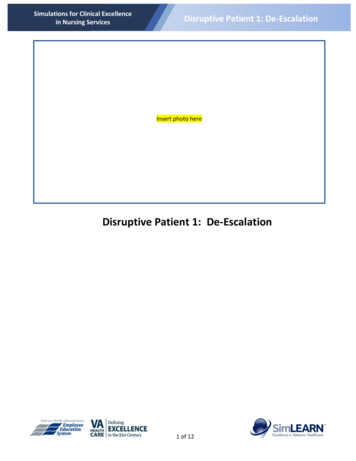
Transcription
Simulations for Clinical Excellencein Nursing ServicesDisruptive Patient 1: De-EscalationInsert photo hereDisruptive Patient 1: De-Escalation1 of 12
Simulations for Clinical Excellencein Nursing ServicesDisruptive Patient 1: De-EscalationInstructor InformationPatient Name: Rolando JonesSimulation Developer(s): Melissa Brickner, Bridgett Everett, Debra A. Mosley, Beverly Snyder-Desalles, and JudyYoungScenario Purpose: To safely and effectively de-escalate the patient exhibiting disruptive behaviorLearner(s): Registered Nurses (RN), Licensed Practical Nurses (LPN), Unlicensed Assistive Personnel (UAP) Others as desired, depending on facility protocols Recommend no more than 6 learners (3 of which can be observers)Time Requirements: Setup: 5 minutes Scenario: 25 minutes Debrief: 25 Minutes Reset/Breakdown: 5 minutesConfederate(s): Significant other Assistance (security officer, police, or facility specific) Standardized patientScenario Prologue: The patient is a 49 year-old male who is becoming increasingly agitated. He is accompanied by hissignificant other. The simulation begins when the learners enter the room OR the patient enters the area (if arriving fromother area)Medications:Patient information: Metformin 500 mg three times daily General: Agitatedwith meals Weight/Height: 113.6kg (250lbs) 182.9 cm (72in) Lorazepam 2 mg every 8 hours Vital Signs: BP 188/92, Temp 97, HR 140, RR 26, O2 Sat 96% Albuterol/Ipratropium inhaler 2 puffs Pain: 6/10 In the lower extremitiesfour times daily Neurological: Numbness and pain in bilateral lower extremities Gabapentin 300 mg three times daily Respiratory: Lungs clear, dyspneic, tachypneic Cardiac: Tachycardic Gastrointestinal: UnremarkableAllergies: Genitourinary: Unremarkable No known drug allergies (NKDA) Musculoskeletal: Gait unsteady Allergic to dairy products Skin: Face flushed; cheeks red oPast Medical History: Post Traumatic Stress Disorder (PTSD), type 2 diabetes, chronic obstructivepulmonary disease (COPD), arthritis, diabetic neuropathy, 30 year one pack per day smoking history, andhe drinks “a few beers a day”Past Surgical History: Appendectomy and bilateral lowerConfederateextremity shrapnel removalChange in Physiology2 of 12
Simulations for Clinical Excellencein Nursing ServicesDisruptive Patient 1: De-EscalationLearning ObjectivesPatient Name: Rolando JonesSimulation Developer(s): Melissa Brickner, Bridgett Everett, Debra A. Mosley, Beverly Snyder-Desalles, and JudyYoungScenario Purpose: To safely and effectively de-escalate the patient exhibiting disruptive behaviorPre-Session Activities: Complete pertinent training on management of the disruptive patient Review VHA Directives, policies and protocols on management the disruptive patient Review interdisciplinary roles when caring for the disruptive patientPotential Systems Explored: What de-escalation techniques are designed for use during disruptive behavior? What standardized protocols currently exist to establish safety for the disruptive patient? When should the healthcare provider consider chemical or physical restraints? What facility specific documentation is required when caring for the disruptive patient? What risk factors, contraindications, and complications are important to consider when caring for thedisruptive patient?Scenario Specific Learning Objectives (Knowledge, Skills, and Attitudes K/S/A):**The learner(s) will demonstrate ICARE principles throughout the scenario.Learning Objective 1: Demonstrate the utilization of Prevention and Management of Disruptive Behavior (PMDB)de-escalation principles to establish safetya. K- Recognize the patient’s behavior as Panic Stress levelb. S- Call/request assistance per facility specific disruptive behavior protocolc. S- Implement PMDB de-escalation principlesA- Maintain a controlled demeanor throughout the scenariod. S- Ensure the patient is away from unnecessary staff, patients, and visitors to establish safetye. S- Establish boundaries with the patientf. S- Locate and remain in close proximity to the exitg. S- Avoid becoming isolated in the room with the patientLearning Objective 2: Implement facility specific protocol for the patient exhibiting escalating disruptive behaviora. S- Initiate facility specific protocol for disruptive behaviorb. K- Discuss interdisciplinary resources availableLearning Objective 3: Utilize effective communication techniques when caring for the disruptive patienta. S- Provide information regarding a potential plan of care that may include a sedativeb. S- Perform ISBAR handoff communicationc. S- Complete facility specific documentationDebriefing Overview: Ask the learner(s) how they feel after the scenario Have the learner(s) provide a summary of the scenario from a healthcare provider/clinical reasoning pointof view Discuss the scenario and ask the learners what the main issues were from their perspective Ask what was managed well and why. Ask what they would want to change and why. For areas requiring direct feedback, provide relevant knowledge by stating “I noticed you [behavior] ”Suggest the behavior they might want to portray next time and provide a rationale. “Can you share withus?”3 of 12
Simulations for Clinical Excellencein Nursing ServicesDisruptive Patient 1: De-Escalation Indicate closing of the debriefing but provide learners with an opportunity to voice one or two take-awaysthat will help them in future practice Lastly, ask for any outstanding issues before closing the debriefCritical Actions/Debriefing Points:1. Recognize the patient’s behavior as Panic Stress level2. Call or request assistance3. Remove the patient to a private area to establish safety4. Implement PMDB de-escalation principles5. Establish boundaries with the patient6. Avoid becoming isolated in the room with the patient7. Locate and remain in close proximity to the exit8. Complete ISBAR communication9. Provide information regarding a potential plan of care that may include a sedative10. Discuss facility specific interdisciplinary resources available11. Complete facility specific documentation4 of 12
Simulations for Clinical Excellencein Nursing ServicesDisruptive Patient 1: De-EscalationSimulation Set-Up(Standardized Patient)Patient Name: Rolando JonesSimulation Developer(s): Melissa Brickner, Bridgett Everett, Debra A. Mosley, Beverly Snyder-Desalles, and JudyYoungRoom Set-up: Set up like an outpatient reception area kiosk. The patient is accompanied by his significant other The patient is diaphoretic, running his fingers through his hair, and tapping his fingers on the deskPatient Preparation: Street clothes Diaphoretic with perspiration under arm pitsHave the following equipment/supplies available: Telephone *Label on phone for notifying emergency mental health team response (depending on facility) *Label on keyboard for notifying emergency mental health team response (depending on facility ) *Emergency alarm for notifying emergency mental health team response (depending on facility ) Keyboard and computer monitor (non-functioning; optional) Gloves Hand sanitizer Blood pressure cuff Stethoscope VA Police identification (shirt, toy badge, prn) depending facility specific response *SimLEARN use VAPolice provided accessoriesNote: 5.8 Simpad software update is required to load impad-upgrade.vs2 Scenarios may be used with Laerdal or LLEAPsoftware.Scenario Supplements: Confederate scripts Confederate and learner name tags Patient identification band PMDB supplement Code Orange Button picture ZZ test patient/Demo patient in CPRS (if desired) ISBAR tool5 of 12
Simulations for Clinical Excellencein Nursing ServicesDisruptive Patient 1: De-EscalationFlowchartInitial State:- Mental Status: Tense, agitated- RR: 24 Labored- Pain level: 6/10 lower extremities- Skin: Diaphoretic The patient is a 49 year-old male presenting to the outpatient clinicaccompanied by his significant other after traveling two hours for anappointment for an unknown reason. He is becoming increasingly agitated. The patient states “I don’t know why I’m here. All I know is I received this paperin the mail and drove two hours to get here! You figure it out!”***Status Change***- Mental status: Increasingly agitated- RR: 34 Labored- Pain level: 6/10 lower extremities- Skin: Diaphoretic The learners enter the room The patient’s significant other states to the patient “Please try to calm down,you are making a scene.” The patient becomes increasingly agitated, clenches his fists towards hissignificant other, uses expletives and states “Say that again and I will shut youup permanently!” Recognizes the patient’s behavior as Panic Stress level Calls/requests assistance by initiating facility specific disruptive behaviorprotocol Ensures the patient is away from unnecessary staff, patients, and visitors toestablish safety Implements Prevention and Management of Disruptive Behavior (PMDB) de-escalationprinciples Establish boundaries with the patient Avoids becoming isolated in the room with the patient Locates and remains close proximity to the exit Assistance arrives Performs ISBAR handoff communication The patient begins to cry and states “I apologize, I really don’t want to hurt anybody. Ijust feel like nobody understands. I get angry so easy now. I get nagged all day since welost our home. We are having so many money problems. I need help.” Provides the patient with information regarding a potential plan of care that may includea sedative Discusses facility specific interdisciplinary resources available Completes facility specific documentationCritical Actions/Debriefing Points:1. Recognize the patient’s behavior as Panic Stress level2. Call/request assistance by initiating facility specific protocol for disruptive behavior3. Escort the patient to a private area to establish safety4. Implement PMDB de-escalation principles5. Establish boundaries with the patient6. Avoid becoming isolated in the room with the patient7. Locate and remain in close proximity to the exit8. Perform ISBAR communication9. Provide information regarding a potential plan of care that may include a sedative10. Discuss facility specific interdisciplinary resources available 6 of 1211. Complete facility specific documentation*Did not implement PMDBde-escalation principles* The door close andlearner(s) will remain in theroom with the patient Patient clenches his fistsand threatens to physicallyinjure all present***Status Change***- Mental status: Increasinglyagitated-RR: 38 Labored- Pain level: 6/10 lowerextremities- Skin: DiaphoreticConfederateRed Text Physiology ChangeRed Border Incorrect Action
Simulations for Clinical Excellencein Nursing ServicesDisruptive Patient 1: De-EscalationSupplementsConfederate ScriptsConfederate Name TagsPatient Identification BandPrevention and Management of Disruptive Behavior SupplementCode Orange Button (Call for Assistance)7 of 12
Simulations for Clinical Excellencein Nursing ServicesDisruptive Patient 1: De-EscalationConfederate ScriptsRolando Jones: Patient (Standardized Patient)Medical/Surgical History: PTSD, type 2 diabetes, COPD, arthritis, diabetic neuropathy, 30 year one pack per daysmoking history, and he drinks “a few beers a day.” Appendectomy and lower extremity shrapnel removalMedications: Metformin 500 mg three times daily with meals, Lorazepam 2 mg every 8 hours,Albuterol/Ipratropium inhaler 2 puffs four times a day, Gabapentin 300 mg three time a dayAllergies: NKDA; Allergic to dairy products The patient will state “I don’t know why I’m here. All I know is I received this paper in the mail and drovetwo hours to get here! You figure it out!” The patient’s significant other will state “Please try to calm down, you are making a scene.” The patient will become increasingly agitated, clench his fists towards his significant other, use expletivesand state “Say that again and I will shut you up permanently!” If PMBD principles are not followed, clench both fists and threaten to physically injure all present stating“Don’t try me! I will take you all down!” If PMDB principles are followed, the patient will begin to cry and state “I apologize, I really don’t want tohurt anybody. I just feel like nobody understands. I get angry so easy now. I get nagged all day since we lostour home. We are having so many money problems. I need help.” Assistance will arrive ISBAR will be provided End of scenarioSignificant Other The patient will state “I don’t know why I’m here. All I know is I received this paper in the mail and drovetwo hours to get here! You figure it out!” The patient’s significant other will state “Please try to calm down, you are making a scene.” The patient will become increasingly agitated, clench his fists towards his significant other, use expletivesand state “Say that again and I will shut you up permanently!” De-escalation techniques will be implemented Assistance will arrive ISBAR will be provided End of scenarioAssistance Assistance arrives The patient will state “I apologize, I really don’t want to hurt anybody. I just feel like nobody understands. Iget angry so easy now. I get nagged all day since we lost our home. We are having so many money problems.I need help.” ISBAR will be provided End of scenario8 of 12
Simulations for Clinical Excellencein Nursing ServicesDisruptive Patient 1: De-Escalation(Standardized Patient)Rolando JonesSignificant OtherConfederate Name TagsAssistancePrint as many Assistance IDBADGES as desired per facility9 of 12
Simulations for Clinical Excellencein Nursing ServicesDisruptive Patient 1: De-EscalationAllergic: NKDA/Allergic to Dairy ProductsJones, RolandoAge: 49000-00-0000Dr. M. SantanaPatient Identification BandPatient Identification Band10 of 13
Simulations for Clinical Excellencein Nursing ServicesDisruptive Patient 1: De-EscalationPrevention and Management of Disruptive Behavior (PMDB)SupplementFour Levels of StressStress LevelNormalModerateSevere Pain Signs and SymptomsHeart rate 60-80 bpmKeen awareness of surroundingsThinking and processinginformation clearlyHeart rate 81-100 bpmPerceptual field decreasedAlteration in thinkingHeart rate near or above 100 bpmProblems processing informationTunnel visionDeterioration of complex motorskillsVery limited perceptual fieldHeart rate over 100 bpmInability to problem-solve orprocess informationBecomes irrational and a potentialdanger to self and othersDevelops increased strength-basedabilities and gross motor skills(hitting, throwing objects, walking,or running)InterventionsOffer the patient assistance and providegood customer service by respondingpromptly in a professional and respectfulmanner. Escalation may be avoided simplyby communicating any anticipated orcurrent plans of care.Verbally intervene by indicating that thebehavior is not acceptable and redirect.Set limits with simply stated directionssince problems processing information areevident at this stage.GAIN the attention of the team and avoidbeing alone with the individual whileapproaching the exit while speaking at thesame time. Yell loudly for assistance if thisis not possible, call security or 911, andactivate the speaker on your phone if able.It may be necessary to consider chemical orphysical restraints at this point perinstitutional protocol if all other effortshave failed.GAINS Mnemonic**Verbal and non-verbal signs and symptoms that indicate potentially escalating and violent behavior**GGestures of anger that include but are not limited to prolonged staring, shaking/clenching a fist,door-slamming, and throwing objectsAActing in a suspicious, fearful, anxious, or hostile mannerINSIncongruent behavior inconsistent with words as in stating that he/she is “fine” while becomingincreasingly agitated and pacing the roomNoticeable signs and symptoms of stress such as flared nares, jugular vein distention, diaphoresis,increased blood pressure and heart rateSystematically tapping feet, pacing, sighing, shaking knees, clenched jaws, or repeatedly runningfingers through the hare or across the forehead11 of 13
Simulations for Clinical Excellencein Nursing ServicesDisruptive Patient 1: De-EscalationCode Orange Button(Call for Assistance)CodeOrange12 of 13
Simulations for Clinical Excellencein Nursing ServicesDisruptive Patient 1: De-EscalationReferencesDavis, C., Landon, D., & Brothers, K. (2015). Safety alert: Protecting yourself and othersfrom violence. Nursing, 45(1), rtment of Veterans Affairs. (2011). VHA National patient safety improvementhandbook (VHA Handbook 1050.01). Washington, DC: VHA Publications.Department of Veterans Affairs Veterans Health Administration. (2013). Mental healthhandbook (VHA Handbook 1160.06). Washington, DC: VHA Publications.Hodgson, M. J., Mohr, D. C., Drummond, D. J., Bell, M., & Van Male, L. (2012).Managing disruptive patients in health care: Necessary solutions to a difficultproblem. American Journal of Industrial Medicine, 55, 1009-1017.doi:10.1002/ajim.22104The Joint Commission. (2016). 2016 Hospital national patient safety goals. Retrievedfrom http://jointcommission.orgKnox, D. K., & Holloman, G. H. (2012). Use and avoidance of seclusion and restraint:Consensus statement of the American Association for Emergency PsychiatryProject BETA Seclusion and Restraint Workgroup. Western Journal ofEmergency Medicine, 13(1), 35-40. doi:10.5811/westjem.2011.9.6867Montalvo, I. (2007). The national database of nursing quality indicators (NDNQI). OJIN:The Online Journal of Issues in Nursing, 12(3), Manuscript 2.doi:10.3912/OJIN.Vol12No03Man0213 of 13
2. Call or request assistance 3. Remove the patient to a private area to establish safety 4. Implement PMDB de-escalation principles 5. Establish boundaries with the patient 6. Avoid becoming isolated in the room with the patient 7. Locate and remain in close




